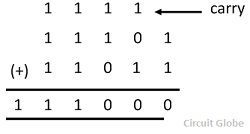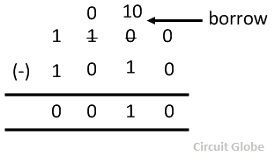The addition and subtraction of the binary number system are similar to that of the decimal number system. The only difference is that the decimal number system consists the digit from 0-9 and their base is 10 whereas the binary number system consists only two digits (0 and 1) which make their operation easier. The addition and subtraction of binary number systems are explained below in details.
For understanding, the binary addition first considers the addition of two decimal numbers as shown below.
 When we added the one’s column of the binary digit (i.e., 7+4) we get the number which is greater than the base of the decimal number (the base of the number is 10 and the sum of the digit is 11). Now add the tens column of the binary digit whose sum is equal to 9, and hence less than the base. So there is no carry in the ten’s column of the binary digit.
When we added the one’s column of the binary digit (i.e., 7+4) we get the number which is greater than the base of the decimal number (the base of the number is 10 and the sum of the digit is 11). Now add the tens column of the binary digit whose sum is equal to 9, and hence less than the base. So there is no carry in the ten’s column of the binary digit.
The solution of the above sum is explained below.
 Binary Addition
Binary Addition
The binary number system uses only two digits 0 and 1 due to which their addition is simple. There are four basic operations for binary addition, as mentioned above.
0+0=0
0+1=1
1+0=1
1+1=10
The above first three equations are very identical to the binary digit number. The column by column addition of binary is applied below in details. Let us consider the addition of 11101 and 11011.
 The above sum is carried out by following step
The above sum is carried out by following step
1 + 1 = 10 = 0 with a carry of 1.
1+0+1 = 10 = 0 with a carry of 1
1+1+0 = 10 = 10 = 0 with a carry of 1
1+1+1= 10+1 = 11= 1 with a carry of 1
1 +1 +1 = 11
Note carefully that 10 + 1 = 11, which is equivalent to two + one = three (the next binary number after 10)
Thus the required result is 111000.
Binary Subtraction
The subtraction of the binary digit depends on the four basic operations
0 – 0 = 0
1 – 0 = 1
1 – 1 = 0
10 – 1 = 1
The above first three operations are easy to understand as they are identical to decimal subtraction. The fourth operation can be understood with the logic two minus one is one.
For a binary number with two or more digits, the subtraction is carried out column by column as in decimal subtraction. Also, sometimes one has to borrow from the next higher column. Consider the following example.
 The above subtraction is carried out through the following steps.
The above subtraction is carried out through the following steps.
0 – 0 = 0
For 0 – 1 = 1, taking borrow 1 and then 10 – 1 = 1
For 1 – 0 , since 1 has already been given, it becomes 0 – 0 = 0
1 – 1 = 0
Therefore the result is 0010.

I like this website much very
thanks for information sirs 🙂
I love this sir thank you very much sir
Amazing explanation…very helpful
Best explanation
Good teaching ,I got a clarity
Thnq guys
Amazing explanation love it
thanks
good tequniqe and explaination. Thanks
Thanks for the explanation.
thanks
this website has helped my children so much. thanks they now know 34+57
ITS SO GOOD TO LEARN
Beautiful explanation
Thank you…The explanation was in a clear and understandable way
best explanation….very helpful…thank you…
Thanks, sir really help full 👍
Thanks alot
Thanks 😊
Very good explanation
👏😍😍😍😍distinction
This is self-explanatory
thanks
Very Good.
Thanks!
Nice tutorial about binary addition.